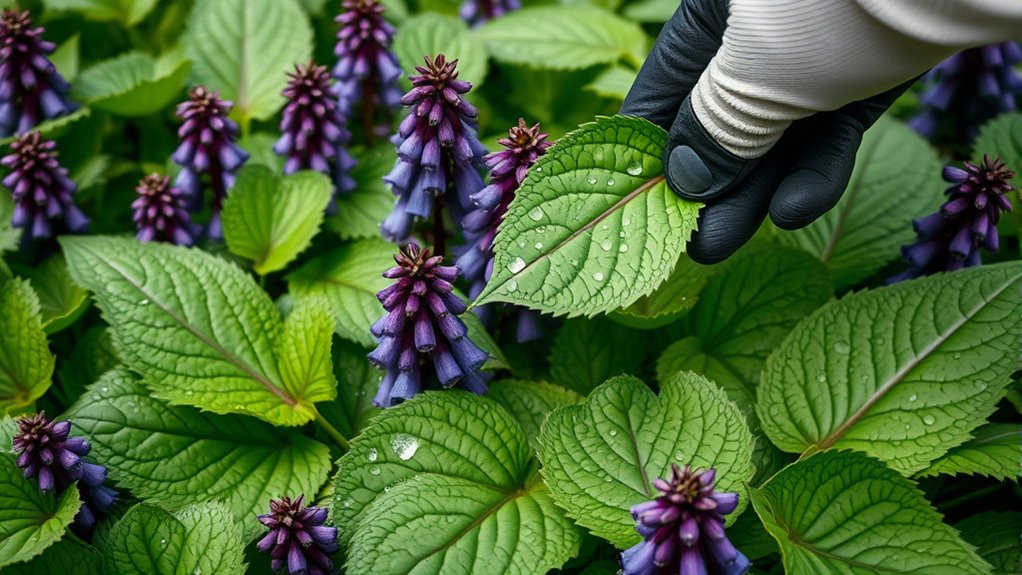When using comfrey topically, it’s crucial to follow safety guidelines to avoid health risks. Apply only a thin layer to healthy, unbroken skin and avoid covering the area tightly. Limit use to a week or two, and never use on large or broken skin, as its pyrrolizidine alkaloids can harm your liver if absorbed in excess. Proper application helps you enjoy comfrey’s benefits while minimizing dangers—discover more ways to stay safe with this powerful herb.
Key Takeaways
- Use comfrey topically only, avoiding internal consumption, to minimize the risk of liver toxicity from pyrrolizidine alkaloids.
- Apply in thin layers once or twice daily for a limited period, usually not exceeding two weeks.
- Do not use on broken skin or large areas to prevent increased absorption of toxic compounds.
- Choose reputable products with low alkaloid levels and always follow recommended dosage guidelines.
- Consult healthcare professionals before prolonged or repeated use, especially if you have underlying health conditions.

Comfrey has long been valued for its healing properties, but it’s important to understand the potential risks involved with its use. While many see it as a natural remedy that can accelerate healing and soothe pain, ignoring the dangers of plant toxicity can lead to serious health consequences. You want to harness its benefits safely, which means respecting its limits and adhering to proper dosage guidelines. This approach empowers you to take control of your health without risking harm.
Comfrey contains compounds called pyrrolizidine alkaloids, which are the primary concern when it comes to plant toxicity. These substances can cause liver damage if absorbed through your skin in significant amounts or over prolonged periods. That’s why topical use is recommended, but even then, it’s essential to be cautious. Never apply comfrey to broken skin or open wounds, as this increases the risk of absorption and toxicity. Pay close attention to how your body responds and avoid prolonged or excessive use, which can lead to unwanted side effects.
Comfrey’s pyrrolizidine alkaloids can harm your liver; use cautiously and avoid broken skin.
Understanding dosage guidelines is essential for safe use. The key is moderation—using only small amounts on targeted areas. Typically, a thin layer of poultice or ointment applied to affected skin once or twice daily is enough. Avoid covering the area with occlusive dressings, as this can increase absorption. Never use comfrey for more than a couple of weeks at a time without consulting a healthcare professional. Extended use or high doses can lead to the accumulation of toxic alkaloids in your liver, risking long-term health issues. Additionally, be aware that certain toxicity concerns may increase when using comfrey in conjunction with other medications or health conditions.
It’s also wise to educate yourself about the plant’s toxicity before incorporating it into your wellness routine. Not all comfrey products are created equal; some might contain higher levels of harmful alkaloids. Always opt for reputable sources that test for plant toxicity and adhere to safety standards. Keep in mind that even with topical use, you should avoid applying comfrey to large areas or over broken skin, as this increases the likelihood of adverse effects.
Your goal is liberation from unnecessary suffering, not exposing yourself to new dangers. Respect the plant’s power, follow dosage guidelines, and limit your use to topical applications. By doing so, you can benefit from comfrey’s healing properties safely, without risking your health. Remember, natural remedies are powerful allies, but only when used responsibly. Your awareness and caution are your best tools to harness comfrey’s benefits while avoiding its risks.
Frequently Asked Questions
Can Comfrey Be Safely Ingested in Any Form?
You shouldn’t ingest comfrey in any form because of its internal toxicity risks. Even small doses can cause serious health issues, including liver damage. If you’re seeking natural remedies, explore safer alternatives. Always follow recommended dosages and avoid internal use unless advised by a healthcare professional. Your health and safety come first, so stay informed and cautious about comfrey’s potential dangers before considering ingestion.
Are There Any Specific Skin Conditions That Benefit From Comfrey?
You can benefit from comfrey for skin conditions that involve inflammation, wounds, or skin regeneration. It’s known for its plant healing properties, helping to soothe irritated skin and promote faster recovery. Use it responsibly, applying it topically to areas needing regeneration, such as cuts, bruises, or eczema. Feel empowered to harness nature’s healing, but always be cautious and avoid internal use to stay safe and maximize its benefits.
What Are Signs of Comfrey Poisoning or Adverse Reactions?
You’ll know if comfrey is poisoning you when you experience intense allergy symptoms like swelling, rash, or difficulty breathing—it’s like an allergy storm inside! Watch for plant toxicity signs such as skin irritation, blistering, or persistent redness. If any adverse reactions happen, stop using it immediately and seek medical help. Don’t ignore these warnings—your body’s signals are breaking free, telling you to protect yourself from harm!
How Long Can Comfrey Be Used Topically Without Risk?
You can safely use comfrey topically for up to a week, but don’t overdo it. Keep an eye on your skin and stop if you notice redness, irritation, or pain. To guarantee your duration safety, limit usage frequency to avoid absorption of harmful compounds. Remember, moderation is key—prolonged or excessive use increases the risk of adverse reactions. Trust your body’s signals and prioritize cautious, responsible application.
Are There Age Restrictions for Using Comfrey Products?
Like a phoenix rising, you’re free to use comfrey products, but age restrictions do apply. Children and teens should avoid it, as their developing skin and bodies are more vulnerable to risks. Always prioritize product safety, and check labels for any age limitations. If you’re unsure, consult a healthcare professional. Your liberation from doubt means safer, more confident use—embrace responsible choices and keep your skin safe.
Conclusion
Remember, using comfrey topically can be helpful, but it’s essential to stay cautious. For example, if you apply it to a deep wound and don’t follow safety guidelines, you risk serious liver damage from absorption. Always stick to recommended uses, avoid internal consumption, and consult a healthcare professional if you’re unsure. By respecting these boundaries, you can safely benefit from comfrey’s soothing properties without exposing yourself to unnecessary danger.









